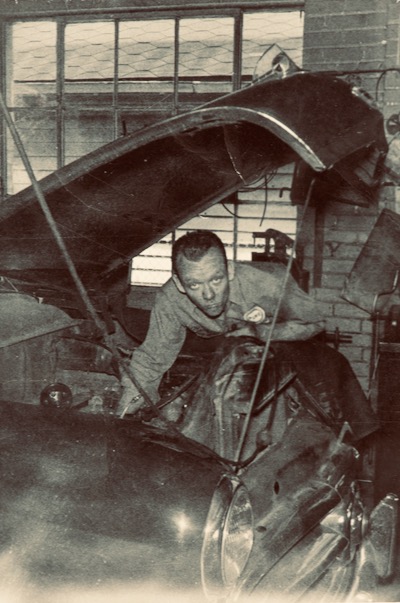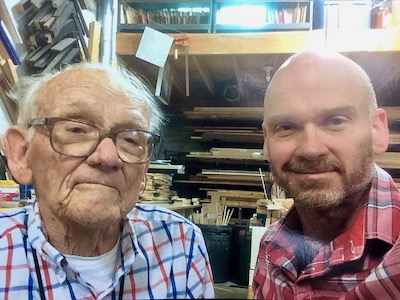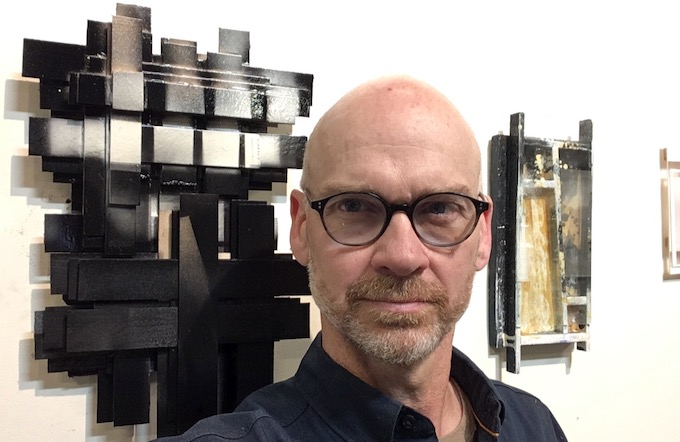
CREATIVE SELF RELIANCE—John Rowland writes, “I took this photo of my father, Paul, in the autumn of 2010 as we were using his air compressor to blow out his sprinkler system before the winter. He was peering out the window of his garage to see if his old machine was still humming along half a century after he toggled it together from spare parts. As you can see, the protective cover over the top is the lid from a plastic trash can. Other components he connected were a motor, an air tank and an air-conditioning compressor he salvaged from an old Ford. Even in 2019, nearly a decade later, his compressor still hums along! Oh, and I forgot to mention the garage! He built that himself in 1968.”
.
By SUZY FARBMAN
John Rowland took the Fifth Commandment to a new level.
He honored his father with a significant exhibition of his work.
John’s an artist who spends much of his time framing pictures for other artists and galleries at his workshop in Ferndale, MI. Though John often frames pieces by renowned artists, his dad wasn’t a renowned artist.
Paul Rowland was a talented mechanic in the experimental development garage of Ford Motor Co. He developed tools and parts for new models. The company held patents on many of them.

GENERATIONS OF CREATIVITY—John writes, “This photo was taken around 1975 as my father was in the process of building a guitar, the first of a number of these stringed instruments he made over the years. Then, as I was looking more closely at this photo, I was pleased that it also includes the violin that was made by Adonis Rowland—his father, my grandfather, who was a fiddle player. It’s the only one we have left that Adonis built by hand, probably in the 1940s. I can still remember the stories my father told about how few tools he had to finish his violins. For example, Adonis found that he could use cut glass to scrape and shape the wood.”
Paul was born in 1925. He grew up in Casey, IL, dropped out of high school, and married the girl next door. The youngest of 9 kids, Paul lived through the Great Depression. That experience, John says, taught his father values of thrift and self-reliance. Paul figured out what he and others needed and crafted it in his garage.
When Paul died last year, John wondered what on earth to do with all his dad’s handmade tools, instruments, jewelry, toys, etc.
Inspiration dawned.
John turned his workshop into a gallery and mounted an exhibit of his father’s creations. John’s friend and professional photographer Tim Thayer took images of Paul’s creations for a catalog John published, “Paul Rowland, American Artisan. Objects from an American Garage.”
In a delightful essay that accompanies the catalog, John recalls stories of his dad’s history as a problem solver.
When Paul was a kid, his house sat across the street from a street light that shone into his room at night when he was trying to sleep. John writes, “It took him no time at all to figure out a way to run a wire from the light to his room so he could turn it off at night. Problem solved.”
Paul became a craftsman who epitomized a term that garners respect in Detroit. He was a “maker.”

STEPPING BACK IN TIME—“With this last photo, we’re going back even further into Dad’s long life of ingenuity,” John writes. “This photo was taken around 1952, when he worked at a gas station in Dearborn repairing cars. Many young adults today don’t remember when these local businesses were known as ‘service stations’ and always had a mechanic on duty. One day, a manager at Ford Motor needed service and was impressed at Dad’s skill. That encounter led to Dad’s long career as an employee at Ford.”
John writes that his father “lived in a world where problems were being solved by inventions and new contraptions, and early on he involved himself in that world of creativity and invention.” He observes that his dad’s life bridged almost a century, from the Great Depression years before World War II to the world of 21st century technology.
Paul taught himself to play guitar, then took apart a Gibson to see how it was made. He made 8 guitars by hand and over 31 dulcimers. John recalls being 10 years old when the family camped in Mountain View, Arkansas, where mountain music played everywhere.
One Friday night the family went to the town square. Locals gathered on an outdoor stage to jam. John watched his dad get up on that stage, “picking and fingering his own hand-built dulcimer in his own special way. I know that was not an easy thing for him to do: Dad loved playing music but he did not like performing. He was never comfortable in front of an audience.“
John’s essay also reveals thoughtful insights about his own artistic practice and attitude. For someone who makes art and works with other artists, John writes about originality. “Being original is a very hard thing to accomplish. Being honest is fraught with temptations. I’m suspicious of most art I see in the world because it is usually neither original nor honest.
“Many people have talent, but few are original. The artist is concerned with conveying an idea through art; aesthetic questions are asked and aesthetic judgments are made. Then there is the craftsman, whose concern is producing a fine object, and here the questions and judgments are basically functional. Both the craftsman and the artist should be concerned with honesty and purity of expression in the work itself. If they are in it for attention, or admiration, or financial gain, they are misguided…
“I’m not sure what to call dad. He was most definitely a maker of a diverse range of original, honest objects. And that in itself is a huge accomplishment of both creation and character. His objects represent both the quiet pride of Old World craftsmanship and the flair of American ingenuity. He is not interested in impressing anyone…
“So let me call him an artisan. A skilled, ingenious craftsman whose work expressed a powerful, intuitive aesthetic.”
John sent out Invitations to “Objects from an American Garage.” About 100 people came to the opening. No doubt, they were bowled over. For that matter, I wouldn’t be surprised if Paul Rowland made his own bowling pins.
And here’s a bonus …
THERE’S MORE! A curator from the Henry Ford Museum in Dearborn, MI, heard about the show and visited John’s studio. “The Henry” now has an exhibit on Detroit makers, “Break, Repair, Repeat.” It includes some of Paul Rowland’s pieces, among them 2 guitars, a paint sprayer and a sewing machine. The Henry Ford exhibit runs until September 15, 2019.
I can only imagine how Paul, a modest man who devoted his life as a mechanic for Ford Motor, is beaming down from some other dimension, having been chosen and displayed by the Henry Ford Museum.
Bravo, John, for recognizing your father’s talents and honoring him in such a special way! It reminds all of us to remember and revere our own legacies.





Suzy,
Well done! I appreciate your interest in our story. The original concept was to document my father’s work and preserve a bit of his story for our family. It is very satisfying to think it has reached beyond that original idea. I can’t help but wonder what my father would make of this attention. He currently has objects being exhibited at The Henry Ford Museum, and now this wonderful article you’ve written. I also love to reflect on the fact that he spent so many years going to work at the experimental garage across the street from ‘The Henry’. He certainly never could have imagined that he would someday have a presence there. What a crazy, wonderful path it has all taken!
John Rowland
As Paul’s daughter and John’s sister, my memories of growing up in a creative family is one of curiosity and invention. We rarely bought things that dad could make. His eyes lit up when a problem presented itself and we could tell the gears were in motion as he bolted to the garage. The entire neighborhood relied upon his ability to fix and solve problems. There are tools on the market now that I recognize as things he created decades earlier, yet, he was humble and self-effacing about his ability and talent. I pride myself in our family and our many diverse “maker” qualities. I still delight in Rube Goldberg contraptions, gadgets and inventiveness. I will be taking my grandchildren to an upcoming Maker Faire.